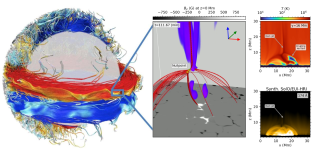Bibcode
Nóbrega-Siverio, D.; Moreno-Insertis, F.; Galsgaard, K.; Krikova, K.; Rouppe van der Voort, L.; Joshi, R.; Madjarska, M. S.
Bibliographical reference
The Astrophysical Journal
Advertised on:
12
2023
Journal
Citations
14
Refereed citations
10
Description
The solar atmosphere is filled with clusters of hot small-scale loops commonly known as coronal bright points (CBPs). These ubiquitous structures stand out in the Sun by their strong X-ray and/or extreme-ultraviolet (EUV) emission for hours to days, which makes them a crucial piece when solving the solar coronal heating puzzle. In addition, they can be the source of coronal jets and small-scale filament eruptions. Here we present a novel 3D numerical model using the Bifrost code that explains the sustained CBP heating for several hours. We find that stochastic photospheric convective motions alone significantly stress the CBP magnetic field topology, leading to important Joule and viscous heating concentrated around the CBP's inner spine at a few megameters above the solar surface. We also detect continuous upflows with faint EUV signals resembling observational dark coronal jets and small-scale eruptions when Hα fibrils interact with the reconnection site. We validate our model by comparing simultaneous CBP observations from the Solar Dynamics Observatory (SDO) and the Swedish 1‑m Solar Telescope (SST) with observable diagnostics calculated from the numerical results for EUV wavelengths as well as for the Hα line using the Multi3D synthesis code. Additionally, we provide synthetic observables to be compared with Hinode, Solar Orbiter, and the Interface Region Imaging Spectrograph (IRIS). Our results constitute a step forward in the understanding of the many different facets of the solar coronal heating problem.
Related projects

The Whole Sun Project: Untangling the complex physical mechanisms behind our eruptive star and its twins
The Sun is a magnetically active star with violent eruptions that can hit Earth´s magnetosphere and cause important perturbations in our technology-dependent society. The objective of the Whole Sun project is to tackle in a coherent way for the first time key questions in Solar Physics that involve as a whole the solar interior and the atmosphere
Fernando
Moreno Insertis

Numerical Simulation of Astrophysical Processes
Numerical simulation through complex computer codes has been a fundamental tool in physics and technology research for decades. The rapid growth of computing capabilities, coupled with significant advances in numerical mathematics, has made this branch of research accessible to medium-sized research centers, bridging the gap between theoretical and
Daniel Elías
Nóbrega Siverio